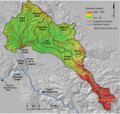| Arroyo Mocho | |
|---|---|
 The Arroyo Mocho as it passes through Livermore The Arroyo Mocho as it passes through Livermore | |
 | |
| Location | |
| Country | United States |
| State | California |
| Counties | Alameda County & Santa Clara County |
| Cities | Pleasanton & Livermore |
| Physical characteristics | |
| Source | Mount Mocho |
| • location | 18 mi (30 km) east of Milpitas |
| • coordinates | 37°27′13″N 121°31′22″W / 37.45361°N 121.52278°W / 37.45361; -121.52278 |
| • elevation | 3,160 ft (960 m) |
| Mouth | Confluence with South San Ramon Creek to form Arroyo de la Laguna |
| • location | Pleasanton, California |
| • coordinates | 37°40′37″N 121°54′44″W / 37.67694°N 121.91222°W / 37.67694; -121.91222 |
| • elevation | 315 ft (96 m) |
Arroyo Mocho is a 34.7-mile-long (55.8 km) stream which originates in the far northeastern corner of Santa Clara County and flows northwesterly into eastern Alameda County, California. After traversing the cities of Livermore and Pleasanton it joins South San Ramon Creek to become Arroyo de la Laguna, which in turn flows to Alameda Creek and thence to San Francisco Bay.
History
Arroyo Mocho means "cutoff creek". Erwin G. Gudde's California Place Names says it got the name because it historically had no outlet but dissipated into the ground after spreading out into many smaller streams between Livermore and Pleasanton. As early as 1852 it was also called Mocho Creek. Frank Latta, in his book on Joaquin Murrieta, says it got its name from the nickname of the man who ran the Murrietta gang's water stations and holding corrals in this area along La Vereda del Monte, the route of their drives of captured mustangs and stolen horses to the south. These stations were on the arroyo near Mud Springs and at Valle de Mocho, what is now known as Blackbird Valley, near the source of the arroyo, just south of Mount Mocho, which was also named for this man, known as "Mocho" (meaning lopped off or short) for his diminutive stature.
Watershed and course
The Arroyo Mocho watershed drains 50 square miles (130 km). Arroyo Mocho originates on the western slope of 3,684 feet (1,123 m) Mount Mocho in the far northeast corner of Santa Clara County and flows west to Mines Road which it follows northwest into Alameda County. It passes rural woodland and grassland along Mines Road. It passes Sweet Springs, a magnesia spring known for its sweet taste. Although historically it sank into the area between Livermore and Pleasanton now the site of multiple gravel pits, there is an engineered channel connecting it to Arroyo de la Laguna.
The underlying aquifer is the Mocho Subbasin, whose eastern boundary is the Tesla Fault. Some groundwater flow occurs across this fault boundary, but flows are discontinuous below a depth of 50 feet (15 m) across the Tesla Fault and south of the Arroyo Mocho channel across the Livermore Fault.
Major watercourses feeding the Arroyo Mocho include the Alamo, Tassajara, Cayetano, Altamont, Arroyo Seco, and Las Positas Creeks.
Ecology and geology
Arroyo Mocho has a self-sustaining rainbow trout (Oncorhynchus mykiss) population, and trout can migrate to the lower watershed from Alameda Creek.
Channels in the Arroyo Mocho watershed are mostly in the forms of arroyos and gullies: characterized as cuts into a broad valley floor, with steep eroding banks. Elevations in the Arroyo Mocho basin are between 60 and 1200 meters; mean annual precipitation is 428 mm on average.
Gallery
-
 Arroyo Mocho flooding during the 2022–2023 California floods.
Arroyo Mocho flooding during the 2022–2023 California floods.
-
 Arroyo Mocho at dusk flowing under the El Charro Rd. bridge. Pleasanton Ridge in the background.
Arroyo Mocho at dusk flowing under the El Charro Rd. bridge. Pleasanton Ridge in the background.
-
 Arroyo Mocho watershed; Livermore is near the right of the green area
Arroyo Mocho watershed; Livermore is near the right of the green area
See also
References
- ^ U.S. Geological Survey Geographic Names Information System: Arroyo Mocho
- ^ "Mount Mocho". Geographic Names Information System. United States Geological Survey, United States Department of the Interior.
- U.S. Geological Survey. National Hydrography Dataset high-resolution flowline data. The National Map Archived 2012-03-29 at the Wayback Machine, accessed March 15, 2011
- ^ "Arroyo Mocho Watershed Map". explore.museumca.org.
- ^ Erwin G. Gudde; William Bright (2004). California Place Names: The Origin and Etymology of Current Geographical Names. Berkeley, California: University of California Press. p. 241. ISBN 978-0-520-24217-3.
- U.S. Geological Survey Geographic Names Information System: Mud Springs
- U.S. Geological Survey Geographic Names Information System: Blackbird Valley
- U.S. Geological Survey Geographic Names Information System: Mount Mocho
- Frank F. Latta, JOAQUIN MURRIETA AND HIS HORSE GANGS, Bear State Books, Santa Cruz, California. 1980.
- Charles H. Hanson; Janet Sowers; Allen Pastron (August 2004). Evaluation of the Potential Historical and Current Occurrence of Steelhead within the Livermore-Amador Valley (PDF) (Report). Alameda County Flood Control and Water Conservation District - Zone 7. Retrieved April 30, 2021.
- ^ "Upper Alameda Creek Watershed – Northern Section". Alameda County Flood Control District. Retrieved 2024-09-24.
- Page Mosier & Dan Mosier (1986). Alameda County Place Names. Fremont, California: Mines Road Books. p. 86. ISBN 978-1-889064-02-4. Retrieved 2013-01-25.
- Environmental Site Screening Analysis, 2127 Railroad Avenue, Livermore, California, Earth Metrics rpt no. 7785, San Mateo, Ca., Feb., 1989
- ^ Bigelow, Paul; Benda, Lee; Pearce, Sarah (2016-07-07). "Delineating incised stream sediment sources within a San Francisco Bay tributary basin". Earth Surface Dynamics. 4 (3): 531–547. doi:10.5194/esurf-4-531-2016. ISSN 2196-632X.
- Andrew J. Gunther; Jeffrey Hagar; Paul Salop (2000-02-07). An Assessment of the Potential for Restoring a Viable Steelhead Trout Population in the Alameda Creek Watershed (PDF) (Report). Alameda Creek Fisheries Restoration Workgroup. p. 90. Retrieved 2013-01-25.